
Piano school director/teacher
Sponsored by the Osaka-Sumiyoshi Rotary Club
Introduction
I was recently selected by the Osaka-Sumiyoshi Rotary Club to represent them as a GSE team member to D-1560 in the Netherlands, and I spent about five weeks there on the study tour. Before I left, I couldn't think of anything related to the Netherlands other than windmills and tulips, but this GSE trip has had a very significant impact on my life and my career.
The Netherlands
We arrived at Schiphol Airport on April 21, 2001 and began our time in the Netherlands being greeted by a large number of Rotarians who had come to welcome us. We then drove from the airport to Neede, a drive of about 2 hours. On the way, all I could see from the car window was the beautiful green scenery, with windmills and meadows passing by, and an occasional canal. When we passed houses, I noticed that all of them had flower boxes outside the windows, with flowers of all colors in bloom. After it turned dark, I was able to see inside the homes we passed and see what the people were doing there because they didn't close the curtains when it got dark.
Battling the water
The history of the Netherlands is one of "battling the water." The Dutch have a famous saying which says, "God created the world, but the Dutch created Holland." This is because one fifth of the land has been reclaimed from the sea, and about two thirds of the population would find itself under water (since so much of the Netherlands is below sea level) if there were no dikes. Windmills, which are now symbolic of Holland, were originally built for the purpose of land reclamation. First, the Dutch built a dike and cut off the water from the sea. Then the water was pumped out of the "lake" using windmills. In this way, the Dutch were able to increase the land area of their country little by little.
Overcoming "Dutch sickness"
The Netherlands used to be characterized as a nation of "high unemployment" and "financial crisis," but today the world is "learning from the Netherlands." The Netherlands is now characterized by "budget surpluses," "high rates of economic growth," "the lowest unemployment rate" and "highest competitiveness" in the EU, and a "highly satisfied labor force." It is considered to be the "honor student" of the EU. The largest factors in helping realize this tremendous turnaround have been the "part-time worker revolution" (causing a decrease in the number of hours worked per employee) and the resulting way in which many people were able to share the work load. The government made it illegal for companies to differentiate between part-time and full-time workers in relation to wages, salary increases and promotions. People were free to choose the way they wanted to work, more families became double-income households, and, as a result, consumption increased and the economy stabilized. There are some people who are holding two jobs at the same time, and if someone is unable to work full-time because of children or the need to take care of an elderly parent or relative, they can switch from full-time to part-time status easily. Later, after things change, they can return to full-time status. Of course, this applies to both men and women. The "Netherlands Model" is not a cure-all, but I certainly admire how they have "changed the social machinery based on the demands and desires of their citizens;" in other words, the government's "humanity."
Human rights consciousness
In 1983, the Netherlands revised its constitution and formally stipulated that the country become a "multi-racial nation." In the Netherlands, any foreigner who lives there more than five years can obtain voting rights, and, of course, he or she is both able to vote and to run for election. Because of the large variety of ethnic groups in the Netherlands, the country is promoting participation in the political process with a mindset of "sharing political authority," and its people are thoroughly taught that prejudice is not to be tolerated. I felt there is a great difference between Japan and the Netherlands in regard to the degree of consciousness regarding human rights.
Anne Frank
We were able to spend two days in Amsterdam, and we visited the house where Anne Frank hid from the Nazis during WW II. The Netherlands is famous the world over as the nation that harbored Anne Frank, and people from all around the world have visited Amsterdam to see where she stayed. Thirteen-year-old Anne spent her days and nights in that small room, without sunlight, holding her breath out of fear of being found, making little noise, and not going outside until she was fifteen. While I was walking through the building, I couldn't think, "This has nothing to do with me since I'm from a different country." Rather, as I thought about her and the others who had so strongly cried out in their heart, "I want to live," while being murdered by the Nazis, I felt that "I have the responsibility to do what I can for the world and for mankind." I also thought how the land on which I was walking there in Amsterdam was an inheritance passed down to later generations by those who had toiled and struggled to preserve it.
Vocational Study Trips
1) Music schools
I had wanted to visit some music schools while I was in the Netherlands, and one such place I visited was the Doetinchem Music School. The school, which was established in 1950, has 50 instructors and 2,500 students ranging in age from 8 to 80. The school teaches all genres and all instruments. Of course, a large majority of the students are adults who are interested in studying music as a hobby. The school has a magnificent concert hall, 2 orchestras and 20 bands, and the orchestras are made up of children, young people and adults. First, I was given a tour inside the school building. The classrooms were located to the left and right of a perfectly straight main corridor. There were a number of classrooms in which every type of instrument could be taught, and there were also rooms equipped with full band ensembles and studios. Upon entering the last door on the right, I came into a room connected to the concert hall. And when I walked into the hall, I said over and over again, "Great! Great!" as I realized how good the acoustics were in the hall. I was allowed to sit in on a rhythm class, pops band class, saxophone class, flute class, violin class and piano class. That school was perfectly outfitted for music learning, and I thought how wonderful it was that those related to the school, the instructors and the students all felt "It's meaningless if music study is not enjoyable."
A class at Doetinchem Music School
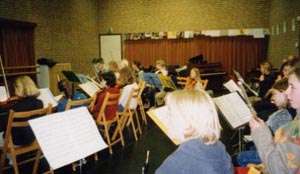
2) Royal Concertgebouw Orchestra
What I wanted to do more than anything else while in the Netherlands was to be able to attend the Royal Concertgebouw Orchestra (RCO), and I was able to do so when my host father in Bennekom, Wim, took me to a concert in Amsterdam. "Concertgebouw" is Dutch for "concert hall." I was sure "royal" meant that the orchestra was associated with the royal family, but when I asked about it, I found that I had been wrong. The orchestra was established in 1888, and the present name was given to it in 1988, by Queen Beatrix when she designated it the "Royal" Concertgebouw Orchestra in commemoration of its 100-year anniversary.
The reason I had wanted to attend that concert more than anything else was that, not only is the RCO considered to be one of the top three orchestras in Europe (along with the Berlin Philharmonic Orchestra and the Vienna Philharmonic Orchestra), but Amsterdam (which had long been renowned as the commercial center of Europe) became, compared to Vienna and Prague, the center of classical music at the end of the 19th century. I knew that the reason Amsterdam had become the "main stage" of European classical music in the 20th century was because of the accomplishments of the Royal Concertgebouw Orchestra. Of course, it is possible to hear them perform in Japan, but there was one more big reason I wanted to see them perform in the Netherlands. I knew that the hall at which the orchestra performs in Amsterdam, the Concertgebouw, is said to be one of the three "acoustically best concert halls" in Europe, along with the Vienna Musikverein Concert Hall (built in 1869) and the Boston Symphony Hall Vienna (built in 1900).
The Concertgebouw is shoe box-shaped, has a capacity of 2,206 (2,037 seated), and accommodates 470 musicians. The echo time is 2.4 seconds when the hall is empty and 2.0 seconds when filled. It is 29 meters wide, 40 meters long, and 15.2 meters to the ceiling. I was surprised by the height of the hall. The vast openness of the hall is something that I was unable to grasp merely from numerical figures, floor plans, and photographs. Not until I was actually able to stand inside the hall did I actually feel its spaciousness. I wanted to experience seeing and hearing a concert there just once in my life, and as I had hoped, I was able to experience with my own eyes and ears "superlative acoustics and music." I wondered, while I was sitting there, why we in Japan, with today's modern technological advances, are unable to build a concert hall with better acoustics than this old hall. I think the reasons are:
a) Concertgebouw was constructed with a huge amount of wood, and this wood was well-aged and of vintage violin quality, and maybe this is why it produces exquisite sound.
b) When the orchestra was established, the science of acoustic construction and the science of structural strength were not fully developed, and the designers didn't have computers to assist them in their design work. For this reason, the builders had to have a tremendously high sense of what made a concert hall good. Analyzing this scientifically a bit more, it may be that:
c) Today, there are regulations regarding construction materials, and there are limitations on what materials can be utilized in the concert hall itself.
d) The amazing fact that the design is such that the difference between echo time when the hall is empty and when it is full is negligible.
e) The hall is quite wide (29 meters). This means there is minimal lateral reflection of sound, no over-echoing, and no garbling of the minute nuances of sound produced by the orchestra.
Besides the wonderful sound and the area around the stage, there is one more thing that makes the Concertgebouw special. The second-floor balcony, which has nice round curves, has name plates embedded in the wood that contain the names of the composers whose works were performed there. Unfortunately, I was unable to find out the history behind this custom or the criterion upon which a composer was selected for this honor.
Anyway, I can still hear in my mind and feel what I felt that night (music that moved me deep within my soul) when I heard a great orchestra perform in a great concert hall.
3) Facilities for the handicapped and music therapy
I was also able to visit a facility for the handicapped (Groot-Schuylenburg, est. 1935) where I learned about music therapy in the Netherlands. The man who accompanied me on my visit was not a music therapist, but he certainly seemed like one to me. He told me, "Music therapy takes place between the person who uses music to help bring about healing (the therapist) and the patient, and it is up to the therapist what method he/she uses." What I observed was not a private session, but rather a group session. Because it was difficult for the people to communicate using words, the therapist used music directly to try to ascertain from their responses and facial expressions what their condition was. Watching the session transpire, I felt that the success of music therapy is dependent much less on theory than it is on the humanness and personality (and the musical ability) of the therapist, and the atmosphere at the time of the session.
A music therapy session
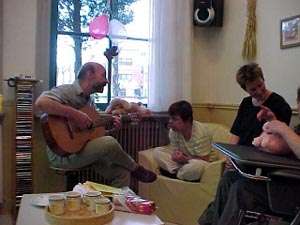
I had heard that social welfare was more advanced in the Netherlands, and I wondered how far Japan had come to date in its welfare system. So I went to a social welfare facility (a "working house" for the handicapped) in Osaka, the Baobob House, and talked to the person in charge, Ms. Atsuko Aman. She said, "The first step in building a facility in Japan is finding the land, and this can take several years. After a good site is located, we must deal with opposition from the surrounding residents (who don't usually want such facilities in their neighborhood), and then comes the long struggle to come up with the finances we need. The government provides us with a total of 13.3 million yen (US$110,000) per year because we are a facility that handles more than 15 people. But, our actual costs for everything involved in the care of the 16 people who come here is about 20 million yen (US$170,000). The work the people are able to do must be simple and not have a time limit, so the type of work we can have the handicapped do here is very limited. We are very grateful for the people who are working here to help us and the many people who serve here as volunteers."
The facility I visited in the Netherlands, Groot-Schuylenburg, is located on a nice green plot of land 43 ha in size, accommodates 710 handicapped people, has 1,210 staff workers, 600 helpers, 500 assistants, and 300 volunteers. The annual operating expenses come to about 4 billion yen (US$33 million), which is paid for by the government. There is a soccer field and swimming pool on the property, as well as a restaurant, and, of course, private citizens may come and use these for a fee. The work being done at Groot-Schuylenburg consists of making parts for bicycles, but what surprised me the most was that some of the people were also assisting the post office by delivering the completed parts (wearing post office uniforms!). How wonderful it was to see handicapped people doing the work of civil servants! I couldn't help feeling the vast difference that exists between the Netherlands and Japan, after visiting Groot-Schuylenburg.
4) Piano factory
At the piano factory, I was shown the manufacturing process and inner workings of a piano in detail. The man who showed me around is also able to repair pianos, and I saw a 200-year-old Steinway and a instrument that looked like a clavichord (the most popular instrument of the 14th century) that were both in pitiful shape. What impressed me the most was seeing a replica of the kind of piano Beethoven and Schumann used in the 18th century that the factory had made. It took them several years to complete that piano, and the keys are all ivory. When I asked them how much it cost to make it, I was told, "I can't put a price on it! We don't intend to sell it. But if we were to sell it, it would be very expensive." I heard that there were many pianists who rented this piano when they were having concerts featuring the music written at the time when pianos like this one were being made. I was given the special privilege of playing that piano while I was there. It had five octaves, and the quality of the sound differed between high notes and low notes. The sound resonated much like a harpsichord. It was quite a realistic feeling getting to play songs written by composers who used pianos just like that one, and it made me feel a little bit closer to those composers. For someone like me, who plays the piano in concerts, it was a very meaningful study trip.
Replica of an 18th century piano
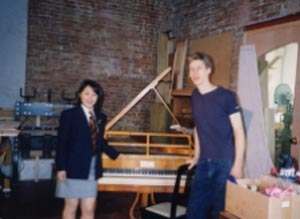
5) My first contact with a carillon, and how they are made
On April 30, the Queen's birthday, we visited a church in the heart of Doetinchem. The steeple tower was 90 meters high and the stairs were narrow and steep. On top of that, it was a spiral staircase, and we had to stop for a breather several times along the way. Finally, about 70 meters up, I saw my first carillon.
In that dark tower, the carillon bells sounded solemn and elegant. As I was admiring the sturdy construction, a carillonist came out of the practice room. She was Japanese! Her name was Midori. Her husband was Dutch, and she has lived in the Netherlands for over 8 years. After giving us a short explanation about the carillon, Midori played a Dutch song on it for us. I was impressed by the intensity of her playing and how she played the instrument. The heaviest bell weighs about 2 tons, and you play the carillon by making a fist and pounding on the wooden keys, while moving both feet simultaneously to play the melody line. Actually, "play" may not be the best word. It was more like "ringing" the bells. I was extremely interested in this instrument, and thanks to Midori and some members of the Harderwijk Rotary Club, I was able to make a vocational study trip on another day to the school where Midori is learning how to play the carillon, the Nederlandse Beiaard School (est. 1953).
In the 14th century, the Netherlands was referred to as Carillon (Carollon). In churches and other tall towers, people would pull on a rope to ring bells in order to announce the time. Since the purpose of the bells was to inform people of the time, it appears that the first carillon were not religious musical instruments. Just like with wine makers, there are many different brands of bell makers, and I guess the bells made by the Emony brothers are reputed to have the best sound. The keys of the carillon are made of wood, and although they are laid out like those of a piano, the number of keys differs from tower to tower. The middle-C key (like that on a piano) is considerably to the left of center on a carillon, and the foot pedals are exactly like those on an Electone (a small, electric organ popular in Japan). There is no need to tune the carillon since the bells are all "tuned" when they are made to they match each other. The tone of the bells changes slightly, however, depending on the weather and humidity, so the carillonist adjusts the sound a little by pulling on wires. There are many carillon songs with beautiful melodies and harmonies, but you cannot find any sheet music for them at a library or sheet music store. The only way you can get music for them is to go to a carillon school and ask them to make a copy for you. When I heard that, I asked Midori if she could get me some carillon music, and she was able to provide me with a copy of the most famous song composed by the most popular carillon composer, Mathias van den Gheyn (1721-1785).
Carillon songs can be played on a piano as well, so I think I will add this song to my repertoire. During my conversations with various Rotarians and at the D-1560 District Conference on May 12, I mentioned that I was very interested in learning more about the carillon's construction and sound, since it was a sound I had never heard in Japan. As a result, many Rotarians sent me CDs and I was even able to attend a carillon concert in the latter half of my trip.
A carillon for practicing on
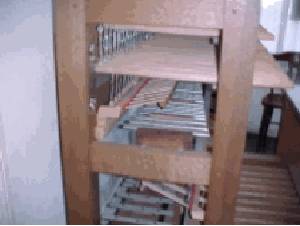
Carillon music
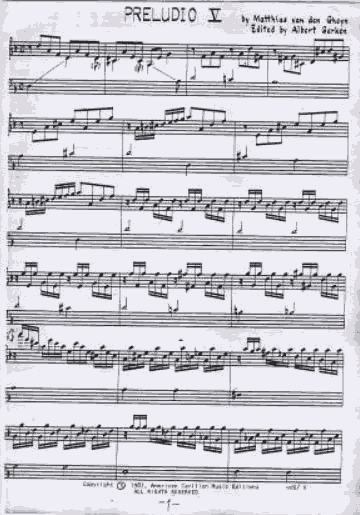
A carillon concert
In the German region of Emmerich, a carillon concert was held at the Aldegonde Kirche church. About 5 minutes before the concert was to begin, there was a large crowd of people outside the church, but I thought it strange that no one had been let inside yet. It was an outdoor concert! Since most carillon are inside church towers, you cannot see them during concerts. Instead, the usual style of concert is to have a video camera set up in the tower and the concertgoers watch the concert on TV monitors while sitting outside on the church lawn. Everyone was quietly listening to the bells with a beer in one hand. The old brick walkway of the church, which was several hundred years old, the light red sunset, and the sound of the bells coming in waves across the breeze, at times strong and clear and other times quieter -- I was intoxicated by the quality and tone of the music.
Playing a carillon
I was able to meet a carillon player named Menry Groen. After introductions, he took me to the old city hall of Apeldoorn. Again, the staircase was narrow and steep. I am afraid of heights, and I was looking all around and wondering if I would be able to play the carillon. Mr. Groen first adjusted the wires on the bells, and then he played a Bach composition and "Sukiyaki" for me. He then turned to me and said, "Let's play a duet!" and he showed me how to play it and how to shape my fist. At first, I had trouble getting used to the playing style, which is completely different than playing a piano. You don't use your fingers at all, but lightly make a fist and hit the keys with the side of your hand. Little by little, though, I grew accustomed to playing it and we were able to play a duet together. My hands were a little sore after we finished playing, but it was a very meaningful experience for me.
Playing a carillon
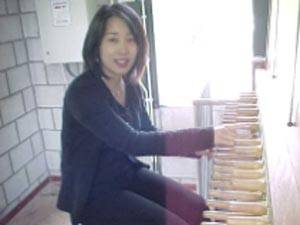
The former Apeldoorn City Hall

General study trips
During our five weeks in the Netherlands, we had the opportunity to visit many different places, such as the city of Munster in Germany, the Japanese embassy, a beer brewery, recycling plant, organic farming company, city halls, a power plant, windmills, a tile museum, soccer match, the Arnhem police headquarters, a "coffee shop" (where people can legally smoke marijuana and hashish), a cigarette factory, a forestry university and monkey park, the Phillips Corporation, a library in Apeldoorn, and more. At each and every place we visited, we were able to speak to people and gain precious experiences and a deeper knowledge of the Netherlands, and I am very thankful for those opportunities. I would have preferred to write about all the places we visited, but since I am a piano teacher I decided to just write about the following things.
What?! He played this?!
One of my most memorable visits was to the Palace het loo in Apeldoorn. The gorgeous palace is surrounded by a forest and I could feel the dignity of the place. The man who gave us a tour was the palace superintendent, Eelco Elzingg. Of course, he is a Rotarian. Thanks to him, we were able to see rooms, hallways, displays, balconies, etc. that normal tourists are not allowed to see. There are many rooms in the palace, and it seemed like a maze to me. If I said it was just like Versailles Palace in France, I think you can imagine what it was like. There were all kinds of things on display (such as dishes, furniture, paintings, etc.) from countries from all over the world. Mr. Elzingg politely explained about all the things we were seeing. In the last room we entered during our tour, we found a piano, and he said to me, "You're a pianist, aren't you?" When I said I was, he said, "I will give you the special chance to play this piano.” We stepped over the sensor and he said, “Please play something." My heart was beating fast as I drew near the piano. I could tell it was very, very old just by looking at it. I played one of my favorite pieces, Beethoven's "For Elise." The keys on old pianos such as that one are heavy and do not come back up in the same way normal keys do on today's pianos, so I had a little trouble playing it. But, I remember thinking to myself how wonderful it was to be able to play Beethoven in such a place, with the unique atmosphere present in an old palace like that.
When I was done, Mr. Elzingg said, "A very famous person
played this piano."
"Really? Who?"
"Franz Liszt!"
I sat there dumbfounded, my breath stuck in my throat. I felt weak and I lost my voice. I have played piano most of my life, but all ten of my fingers began to tremble then. When he saw my reaction, Mr. Elzingg said, "Please, play another piece."
"What?!" I started to panic. My mind went blank and I had no idea what to play. I finally selected Chopin's "Waltz of the Puppy (Valse op 64 no. 1)," but my hands were shaking so much I could hardly play. One thought kept running through my mind, "This can't be true!!!" My right leg and pedal foot were shaking so badly, and I couldn't stop it. But, I finally managed to finish the song. I wondered if I was the first Japanese to play this venerable piano. Later, I learned that Liszt had written a song for the queen, and when he performed it for her, he had used this piano. I have never been more glad in my life than that day that I am able to play the piano. I want to express my heartfelt thanks to Eelco Elzingg for allowing me to have such a wonderful experience.
The front of Palace her loo

Host Families
I am so thankful to the six host families I stayed with. They put their work and other responsibilities aside, saw me off and went to meet me when I went on trips, and explained things to me in more detail when I got home that I had not been able to catch during vocational study trips. They made my meals, took care of all my immediate needs, and went along with me no matter how early in the morning that day's plans started. And in particular, I was so glad that every one of the homes I stayed at had its own piano. I was able to practice everyday, sing with my host families, and play for them. I will never forget all my hosts did for me. I would love to write about so many things, but I will just mention the things that particularly impressed me. (I referred to all my host parents as Dad & Mom.)
Ron & Padgie (Neede RC)
they were my first host family, I was filled with tension and uneasiness and wondered if I would be able to open up to them, but they welcomed me so warmly that it wasn't a problem. During my vocational study on the third day, I got sick and came home with a fever. Dad and Mom took care of me so well that I was able to recover quickly and was fine by the next morning. Dad owns a company that makes shirts, including police uniforms. He was very kind and gentle with me, and gave me this advice. "You must not be afraid to speak!" He told jokes, and made me laugh. On my first morning there, we had the following conversation when I began cutting some cheese at breakfast time.
"I'll do it!" he said.
"I can do it myself!" I replied.
"No you can't!"
"It's all right."
"No it isn't! You're a pianist, and you must be careful not to cut your
finger. Besides, you're my daughter, so ..."
What could I say after that?! I was very happy to hear it.
Mom was always asking me, "Do you have anything you want
me to wash?" "If you have trouble with anything, be sure to let me
know." She told me that her brother is living in Tokyo, and so she knows
a lot about Japan. She asked me,
"You always eat rice with your meals, right?"
"Yes."
"I eat rice often too, so if you want some, you just tell me. OK?"
"Thank you!"
"Tonight, we are going out to a Japanese restaurant!"
"Really?"
"Yes. We and our children all like Japanese food very much!"
Mom is a good singer, so she often sang along with me when I played something on their piano. I still have fond memories of a Carole King song we did together.
On our last day in Neede, I remember crying like a baby. I had made so many wonderful memories in those short 5 days. Ron and Padgie continued to write to me and send me e-mail even after I left for another host family. Thank you so much!
At the farewell party Ron and Padgie held for me

Anton & Rita Schaars (Doetinchem RC)
My second host parents were very kind too. They spoke slowly and listened very attentively when I played the piano for them. Dad is a doctor, but he retired two years ago. In particular, he like to hear me play "Sakura, Sakura," and he enjoyed playing his flute along with me or singing while I played. We went cycling and shopping together, and I was very happy when he stayed with me from the start of my breakfast until the end, even though all he ever ate for his breakfast was just one apple.
Mom attends a computer school once a week, and we talked about many different things while looking at her laptop computer. She is a very good pianist, and she played for me. Thank you!
Bram & Willeke Admiraal (Harderwijk RC)
Bram is a pilot for KLM, and Willeke teaches modern art. They have both been to Japan many times, and they know quite a lot about Japanese culture and customs. It was very interesting talking to them about the differences between the Netherlands and Japan (our food, customs, etc.). I will never forget how they, even though they are vegetarians, bought and prepared steak for me while I was with them. I am so thankful for all they did.
Wim & Hannie van Lindonk (Bennekom RC)
My fourth family lives in a very quiet residential area. We ate our meals together everyday while listening to the birds singing in the backyard. The first time I met these Rotarians, I was wandering around wondering which couple was my host family when they came up to me and said, "It's us!" Mom took my hand and squeezed it, and with a big smile on her face said, "Nice to meet you!" After that, she led me around by the hand during the party. During our "free day" together as a host family and guest, they took me to see a classical music concert and to see a live jazz performance. The day I left, they went to their flower garden, picked a lily of the valley (which I really like) and gave it to me as a going-away present. I was so happy.
Breakfast with Wim & Hannie

Ank & Ben Hasselbach-van Gastel (Arnhem RC)
My fifth host mother is a Rotarian, and she was so considerate in organizing the plans for my time in Arnhem. She heard that I was interested in the carillon from some other Rotarians, so she made arrangements for me to attend a carillon concert, for which I am very grateful. Dad prepared Indonesian food for us one day and it was superb. The three of us also made chocolate cake together, which was a lot of fun. Thank you very much.
Philip & Ans Frank-van Essen (Apeldoorn RC)
When I arrived at the home of my last host family, I was speechless when I saw the size of their house and yard. Dad is a pharmacist and he owns and operates his own pharmacy. In the past, I often had asthma, so Dad carefully explained to me how to breathe when an asthma attack comes on. Mom is a therapist, and she is studying psychology now. They are both very active and open-hearted, and they told me many things about Dutch culture, mad cow disease, their patients, and other things. Thank you!
In Conclusion
I am filled with gratitude for the many things I was able to learn during my five weeks in the Netherlands. After completing the trip, I realized that it is possible to communicate with people even when you don't speak the same language well. I was able to communicate with people through my music, and I am so thankful that I am a pianist and that I studied music. I cannot express how thankful I am to my teacher at music school, Shinobu Yamada, to my mother and my family, and to all the others who have guided me throughout my life. I want to apply the things I learned in the Netherlands to my work, as well as my realization that music is a language understood the world over, and the things that moved me and made me think. And I want to share all these things with as many people as I can.
Lastly, I would like to thank everyone in the Rotary Clubs of D-1560, D-2660 GSE Chairman Nomura and the others on the GSE Committee, all the Rotarians who helped me, those at my sponsoring club (Osaka-Sumiyoshi RC), and those who worked in the background to make this program a success. Thank you very much!